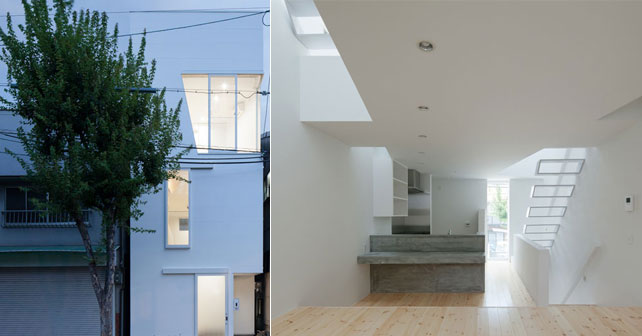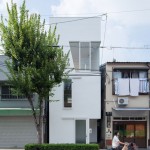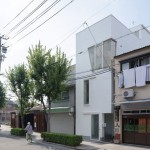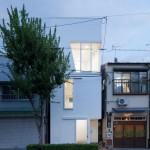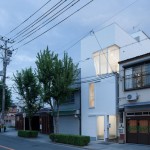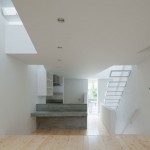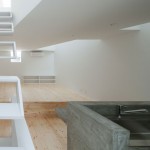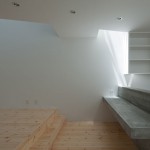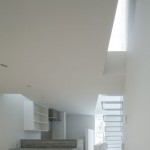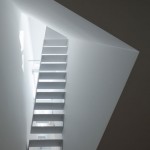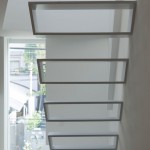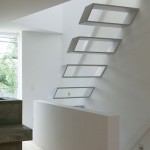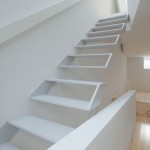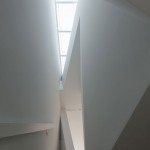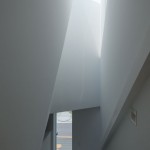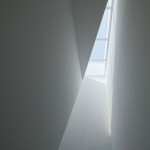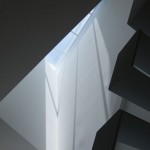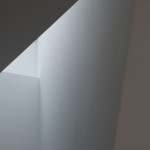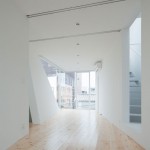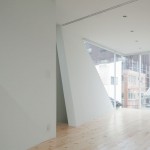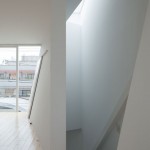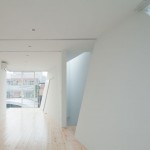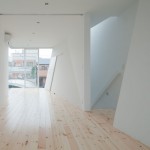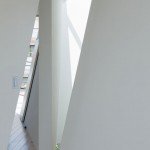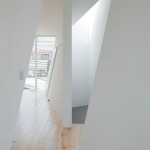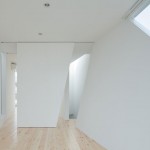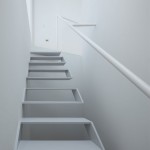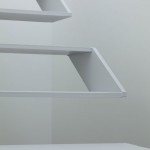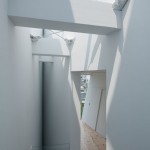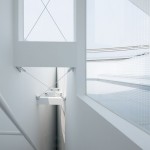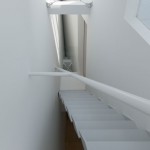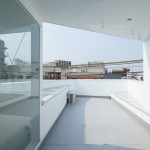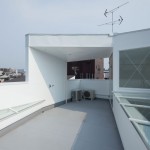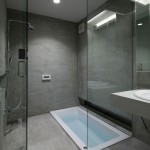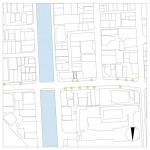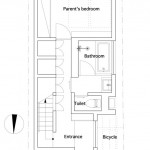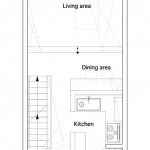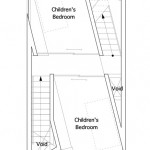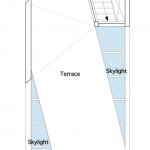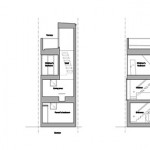Casa en Tamatsu (Osaka, Japon) por Ido Kenji Architectural Studio. La casa esta diseñada para una familia de cuatro miembros con dos niños. La casa esta ubicada en un distrito urbano de Osaka, Japon, y en un pequeño lote de tan solo 43.21 m2.
Alrededor del terreno se encuentra un area de uso mixto en la cual, pequeñas viviendas, industrias y edificios de oficinas coexisten sin ninguna armonia.
El inmueble que se emplazaba anteriormente en el lote, propiedad del comitente, consistia en una casa de madera de dos plantas.
Los edificios adyacentes se ubican muy proximos al lote y la luz natural no lograba ingresar a la antigua casa.
Por lo tanto el cliente solicito un area de uso familiar (estar, comedor y cocina) que fuera lo mas amplia posible, sin columnas o muros portantes que la atravesaran, de forma tal que la luz natural pudiera ingresar al interior de la vivienda, especialmente dentro del area de uso familiar.
En primer lugar, dado que el lote es muy estrecho, el volumen del edificio ocupo el terreno tanto como fue posible.
De acuerdo al estilo de vida del cliente, el dormitorio principal (destinado a los padres) y areas humedas (baño y toilette), se ubicaron en la planta baja de la vivienda.
El area de uso familiar (estar, comedor y cocina) se ubico en el primer piso y los dormitorios de los niños se ubicaron en el segundo piso. En el ultimo piso se ubico una terraza.
Por cuestiones estructurales, no fue posible ubicar grandes aberturas hacia la calle en el primer piso de la vivienda.
Por esta razon, se roto 14º el volumen del segundo piso respecto al eje principal del lote, y espacios intersticiales ubicados entre el muro rotado y el muro exterior, se convirtieron en huecos.
Sobre estos huecos se ubicaron claraboyas, con el objetivo de permitir que la luz natural ingresara al area de uso familiar ubicada en el primer piso.
Por otro lado, uno de los dos muros rotados 14º en el segundo piso esta ademas inclinado respecto de su verticalidad, y la parte que se solapa con las escaleras se eleva como un doblez de origami.
Este muro inclinado provoca una sensacion de liberacion por la desviación de la norma, al mismo tiempo que el grado de inclinación y la luz reflejada en ese plano, estimula los sentidos.
La caja blanca que conforma la imagen exterior del edificio es completamente diferente a las construcciones vecinas.
En la fachada pareciera que el volumen cilíndrico de la segunda planta girada 14º penetra en el edificio y las cajas de escaleras en voladizo flotaran en el vacio.
Ficha técnica
Nombre: Casa en Tamatsu
Ubicación: Osaka, Japon
Arquitecto: Kenji Ido / Ido, Kenji Architectural Studio
Fecha de proyecto: marzo 2011 a febrero 2012
Fecha de construccion: marzo 2012 a julio 2012
Estructura: Masakazu Taguchi / Taguchi Atelier Planning Structure
Superficie construida: 94.46 m2
Superficie terreno: 43.21 m2
Fotógrafo: Yohei Sasakura
Contacto: http://kenjiido.com
English version
House in Tamatsu
The house is designed for 4 members of a family with two kids.
The house is placed at urban district and a small plot of only 43.21 sqm in Osaka, Japan.
Around the site is the mixed-use area where small houses, small factories, and small office buildings coexist together without any harmony.
The client’s former house, which stood at this site, was a wooden two-story house. The adjacent sites were close and natural light didn’t enter into the old house.
Therefore the client requested the family room (living area, dining area and kitchen) to be as large as possible without pillars or road-bearing walls, and that natural light that comes into the house, especially into the family room.
First, since the site was narrow, the volume of the building took up as much of the site as possible.
According to the lifestyle of the client, the bedroom of the couple and wet areas were placed in the ground floor, the family room was placed in the first floor, the rooms of children were placed in the second floor and the terrace was placed on the roof.
For a structural reason, the large openings were not able to open out on the road side of the first floor of the building.
So, I rotated the volume of the second floor 14 degrees for the axis of the building, and interstitial spaces between the rotated wall and the outer wall of the building became voids.
The skylight was set up in the upside of the void, and is intended to allow natural light to drop on the family room of the first floor.
Moreover, one of two walls rotated 14 degrees on the plan of the second floor is also inclined to the verticality, and the part which overlaps with stairs is turned up, and has become like origami or a facet.
This inclined wall frees people’s feeling by deviation from the norm, simultaneously the sense of touch of the degree of inclination and the light to reflect of that inclination cause a new physical sense.
The building’s white box is completely different from the building of the neighborhood.
It is the appearance which the cylindrical volume of the second floor rotated 14 degrees penetrates into the building.
Box-shaped cantilevered stairs are floating in the void.


